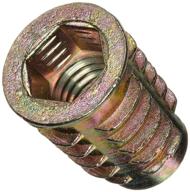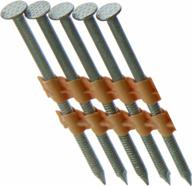What Are Collated Fasteners and When to Use Them
Collated fasteners are a type of hardware that comes connected together on a strip or coil for use in power tools. The most common types of collated fasteners are screws and nails.
How Do Collated Fasteners Work?
Collated fastening systems allow the user to connect materials together quickly and efficiently. The fasteners are loaded into a tool magazine or coil nailer. As the tool operates, it strips a fastener from the coil or strip and drives it into the target material.
- Screws are held together on a plastic strip with glue.
- Nails are held together on a wire or plastic coil.
This collated arrangement allows many fasteners to be loaded at once for rapid, continuous placement. It eliminates the need to manually place each fastener before driving it.
Types of Collated Fasteners
Some common types of collated fasteners include:
| Fastener | Details |
|---|---|
| Collated screws | Available in various head styles and thread sizes. Used for wood, metal, and other materials. |
| Collated nails | Offered in different shank types and sizes. Used for nailing wood together. |
| Collated rivets | Used to join metal, plastic, or other materials by deforming the shank. |
| Collated staples | Used for attaching building wrap, roofing felt, wiring, and insulation. |
Benefits of Collated Fasteners
Using collated fasteners offers several advantages over using loose fasteners:
- Faster driving time since each fastener is already lined up and ready to go.
- More consistent spacing between fasteners.
- Less fatigue on the operator's hands and wrists.
- Lower chance of dropping or losing fasteners.
- Higher productivity with fewer delays.
When to Use Collated Fastening
Projects well-suited to collated fasteners include:
- Roofing, siding, and deck construction
- Securing framing lumber and subfloors
- Connecting drywall, plywood, and other sheathing
- Building wood trusses and furniture
- Assembling metal frames and equipment
Any application that requires many repetitive fastener placements can benefit from collated fasteners and power tools designed for them. They are commonly used by construction crews, metalworkers, woodworkers, and manufacturers.
Choosing Collated Fasteners
Consider factors like fastener size, material, coating, and spacing when selecting collated fasteners. They must be compatible with the tool being used. Talk to suppliers to find the right options for your specific applications.
Collated fastening systems deliver speed, consistency, and efficiency to a variety of construction and manufacturing tasks. If you find yourself driving a lot of loose fasteners by hand, explore how collated options could optimize your workflow.
Types of Collated Fasteners: Screws, Nails, Rivets, etc.
Collated fastening systems are available with a variety of fastener types to suit different applications. Here are some of the most common options:
Collated Screws
Collated screws feature heads (such as hex, Phillips, square, or star) and threaded shanks. They are held together with adhesive on plastic or paper strips.
- Wood screws - For securing wood materials together. Various lengths and diameters.
- Drywall screws - Special sharp point and fine threads for connecting drywall to wood/metal.
- Deck screws - Thicker, coarser threads resist pull-out in decking lumber.
- Self-drilling screws - Can pierce light gauge metal on their own before threading in.
Collated Nails
Collated nails have a formed head and smooth shank. Available in different lengths and shank diameters.
- Common nails - General purpose sharp point for wood framing.
- Finish nails - Smaller heads for furniture, trim, and delicate work.
- Brad nails - Headless shanks for inconspicuous fastening.
- Roofing nails - Larger diameter shanks with ringed shanks for roof sheathing.
Collated Rivets
Rivets with hollow tubular bodies that flare outward when driven to form a head. Used with metal, plastic, and other materials.
- Blind rivets - Single-ended for fastening thin sheets where only one side is accessible.
- Drive rivets - Double-ended for joining thicker materials from both sides.
- Self-piercing rivets - Can drill their own hole before setting.
Other Collated Fasteners
- Staples - U-shaped fasteners for building wrap, roofing, wiring, insulation.
- Pins - Headless fasteners used for pivoting joints.
- Tacks - Small fasteners with flat heads for upholstery, carpeting, etc.
Choosing the right collated fastener type allows efficient, repetitive driving with nail guns and other powered fastening tools. Consult suppliers to select options compatible with your equipment and projects.
Benefits of Using Collated Fastening Systems
Collated fasteners offer several advantages over using traditional loose fasteners. Here are some of the top benefits of using collated fastening systems:
Increased Speed
With collated fasteners, the next fastener is always lined up and ready to drive. This eliminates the need to manually place each fastener, resulting in significantly faster installation times.
Consistency and Accuracy
Since collated fasteners are precisely spaced, they enable consistent, evenly-spaced fastening. This leads to professional, neat-looking finished products.
Fewer Jams and Misfeeds
Loose fasteners can jam inside tools or fail to feed properly. Collated strips and coils prevent jams by keeping fasteners separated and oriented correctly.
Less Fatigue
Repeatedly handling individual fasteners can strain hands and wrists. Collated systems minimize fatigue by reducing manual handling of fasteners.
Higher Productivity
With fewer jams, misfeeds, and delays, workers can accomplish more in less time. Projects move along faster and more efficiently.
Lower Costs
Higher productivity means lower labor costs. And less rework from improper fastening reduces material waste costs.
Safer Working Conditions
Features like stick framing nails help stabilize lumber while nailing to prevent slips. This enhances safety for framing crews.
Simple Loading
Most collated screw and nail tools have easy, drop-in loading features. Coils or strips feed directly into the tool magazines.
Fewer Dropped Fasteners
It's easy to fumble small loose fasteners, costing time chasing dropped screws across the floor. Collated fasteners stay connected until driven.
The precision and efficiency of collated fastener systems lead to improved productivity, lower costs, and higher quality finished products. Investing in the right collated fastening tools for your trade can deliver significant benefits.
Choosing the Right Collated Fastener for Your Project
With the wide variety of collated fasteners available, it’s important to select the best option for your specific project. Here are some key factors to consider when choosing collated fasteners:
Materials
Match the fastener material to the materials being joined. For example:
- Steel fasteners for joining wood, steel studs, and other metals
- Stainless steel fasteners for exterior projects and wet environments
- Hardened fasteners for masonry applications
Size
Consider the thickness of the materials. For example, longer fasteners are needed to join 2x4 studs versus attaching plywood sheathing. Using too short or too long of a fastener won’t create a secure connection.
Load Capacity
Choose fasteners rated for the required load levels. For instance, coarse thread deck screws have higher shear and pull-out strength for structural decking than finer thread drywall screws.
Head Style
Look for the appropriate drive type, such as Phillips, square, or Torx, to match your drivers. Also ensure the head size corresponds to the shank diameter.
Collating Method
Consider plastic strip, paper strip, plastic coil, or wire coil based on fastener type and tooling. Plastic and paper strips are common for screws while coil nails use wire or plastic coils.
Coatings
Coatings like galvanizing, ceramic, or polymer can provide corrosion resistance and ease of driving. Make sure coatings are compatible with your project materials.
Code Approval
For construction projects, ensure the fasteners meet any applicable building codes for your area and application.
Talk to your fastener supplier about the specific demands of your upcoming project. Providing details on materials, environment, and desired results will help them recommend the optimal collated fastener product. Taking the time to choose the right option can make a big difference in achieving fast, reliable, long-lasting connections.
Using Collated Fasteners with Nail Guns and Other Tools
Collated fasteners are designed to work with power tools for efficient, high-volume fastening. Here are some tips for using collated fasteners with nail guns and other fastening tools:
Nail Guns
Coil and stick nailers are specifically designed for collated nails. Nails are fed from a magazine or coil into the nosepiece where they are driven into the workpiece with a powerful piston.
- Use nail size, type, and collation (plastic/paper strip or wire/plastic coil) recommended by the tool manufacturer.
- Adjust depth and air pressure settings according to nail size to properly set the nails.
- Keep the nailer properly lubricated for smooth feeding.
- Load collations carefully to prevent jamming at the mouthpiece.
Screw Guns
Collated screw systems allow rapid driving of multiple screws with a drywall or power screw gun. The screw strips/clips feed directly into the screw gun nose.
- Choose the correct style plastic/paper screw strip to fit the screw gun.
- Adjust torque settings to prevent over or under-driving.
- Ensure the screw gun nose piece is clean and aligned to prevent jamming.
- Apply smooth, consistent pressure on the screw gun to keep the strip feeding.
Rivet Tools
Collated rivets come on strips or coils designed for automated rivet guns. The rivets index into the nosepiece and are upset with hydraulic or electric power.
- Select strips/coils compatible with your rivet gun model.
- Use proper rivet size for the materials thickness.
- Adjust pressure/stroke according to rivet size for optimal upset.
- Check jaws for wear and alignment to prevent jamming.
By following the manufacturer's instructions for your specific tools, collated fasteners can help take the fatigue and repetition out of driving large quantities of fasteners accurately and efficiently.
Collated Fasteners for Efficiency, Productivity and Convenience
Collated fastening systems offer a range of benefits that can optimize workflow and results for professionals across many trades. Here's how collated fasteners deliver improved efficiency, productivity, and convenience:
Efficiency
By lining up fasteners in coils or on strips, collation eliminates the need to position each fastener individually. This streamlines the fastening process, allowing workers to drive more fasteners in less time.
- Consistent, even spacing between collated fasteners saves time measuring and marking.
- Smooth, continuous driving motion with fewer interruptions.
- Minimized jamming compared to loose fasteners.
Productivity
The time savings and streamlined workflow add up to improved productivity. More fastening tasks can be accomplished per worker per day.
- Get larger jobs done faster with fewer workers.
- Consistency leads to less rework and wasted effort.
- Lower fatigue means workers can sustain fast pacing for longer periods.
Convenience
Collated fasteners are designed for easy handling and loading into tools.
- Coiled nails and screws feed directly from box into tools.
- Strips allow simple placement into screw gun or rivet tool magazines.
- Less fumbling with small loose parts.
The benefits are clear across many applications from framing to roofing to mechanical assembly. Contractors, builders, manufacturers, and more can gain an edge with collated fastener systems. The technology exists to make fastening tasks go faster and easier - put it to work and see the time and money saved add up on every project.











